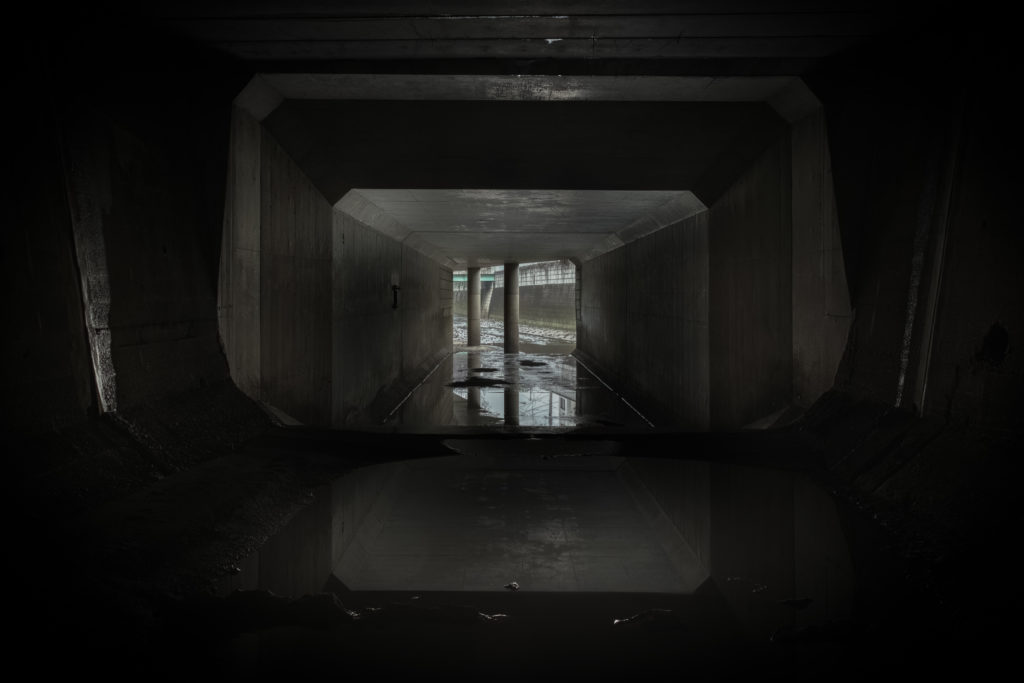Endogenous error terms
Mischa Leinkauf | ミーシャ・ラインカウフ
15 April – 8 July, 2019
Opening night reception with + publication launch: 15 April , 19:30 – 21:30
|
ベルリンを拠点に活動するドイツ人アーティスト、ミーシャ·ラインカウフ(Mischa Leinkauf)は、過去15年間にわたり、景観や都市計画と人間の関係を、彼自身として、または幼馴染であり悪友のマティアス·ヴェルムカ(Matthias Wermke)と組むアートデュオ、ヴェルムカ/ラインカウフの一部として再定義し、社会政治的な問題や、彼にとって「個人的な自由の例」と解釈するものを探求してきた。ラインカウフの作品は、多くの領域にわたり、ビデオ/映画のインスタレーションや写真による記録の形をとりながら、個人や集団の記憶の中の歴史的、政治的、文化的な概念を引き合いに出しながら公共空間の境界や物理的耐久性の限界を追究するパフォーマンスに代表される。 国際的に高く評価されているラインカウフの作品の多くは、ゲリラ的なパフォーマンスを連想させる素早く完全に計画された妙技と非常に概念的な背景を融合させた作品を作る能力が根本にあるが、最終的に展示される作品の主旨は、自然発生的で直感的だ。作品はアクセス可能であり、すぐに親近感と共感を得られる。一見すると、パフォーマンス行為の多くは、向こう見ずなパルクールやアドレナリンを誘発するアクロバットを思い起こさせる。それにもかかわらず、歴史的·文化的背景から、ラインカウフは芸術作品として都市景観を詩的に再構成することができる。 この10年間においてラインカウフの最も有名な作品は、ヴェルムカとのアートデュオとして創作されたものである。特に2014年に、ドイツ生まれの米国人建築家ジョン·A·ローブリングの逝去145周年を記念して、ニューヨークの象徴的モニュメントであるブルックリン橋の塔の上に、二つの手作りの白いアメリカ国旗が標準旗からすり替えられる作品があり「White American Flags-白いアメリカ旗」 と題された。このような匿名の行為は、全世界のマスコミと国民の想像力をかき立て、国際的な波紋を広げた。 ラインカウフ個人での作品は、社会活動的でありながらも危険というよりは探求といった面に重点を置いている。落ち着きが増し、ヴェルムカとの共同作品から発展させたものとなっている。 このザ·コンテイナーでの展示のために作られたビデオインスタレーションの仕事は、7年以上前に始まり、ラインカウフはトーキョーワンダーサイト(現在はトーキョーアーツアンドスペースと改称されている)での半年間のレジデンスを終えると2011年の東日本大震災とそれに続く福島第一原子力発電所の事故が起きた。地震、津波、そして原子力の危機は彼に強烈な印象を残し、普段は見ることができない、あるいは探索されない保護された都市建築空間の調査を試みた。彼の研究は、街の地下にある道路やトンネルなど全体的な地下システムへと導いた。もともとは、川や潮の流れをコントロールするために地下を掘ることによって、過去数世紀の間に作られたものである。こういった秘密の場所のいくつかは、渋谷の交差点のような東京の最も象徴的な場所の下に隠されている。 彼にとって、予期せず、通常は無人で非居住の空間が発見されたことは、不確実な状況や緊急事態においても安全と安心を提供でき、保護され、守られた公共の場所の存在を意味した。自然災害や人的災害から真の意味で守られている唯一の都市空間を形成し、住民に最も基本的な人間のニーズである「安全」を提供している。彼は急速にこれらの空間に魅かれるようになった。都市の日常生活を観察したり、都市のDNAに組み込まれていることを経験したりすることは、賑やかな大都市の建設と発展に不可欠な内生的プロセスである。このように内から生じる感覚は、その都市のゲノムを定義する生物や細胞内から進化してきた活動であり、ラインカウフは都市の子宮の中で保護され、包み込まれているという心理的な感覚を生み出している。 東京を訪れてからその後7年間、彼はアテネ、ミュンヘン、ウィーン、フィレンツェなどのヨーロッパ中の都市を含む世界中の同様の地下システムを探検し、記録し、その活動はモンゴルにまで拡大した。 ザ·コンテイナーでは、新しいビデオインスタレーションとして、彼の長年の仕事、研究、そして広域な旅行による成果を、プロジェクトのきっかけとなった東京の街で披露することを嬉しく思います。 この作品は、コンテナ内に投影され、スペースの背面壁全体をカバーするシングルチャンネルのビデオ装置として表示されます。このインスタレーションは、展示スペースの映像に没頭できるような配置を利用して、真っ暗な状態から始まり、視聴者を混乱させ、空間の錯覚を作り出します。実際のトンネルの場合と同様に、ラインカウフは入口と出口の曖昧さを再現し、これらの空間が生み出す物理的、心理的な影響を模倣するようにコンテナを変形させようとする。 駐日ドイツ連邦共和国大使館の寛大な支援なしには、この展示は不可能であったであろうし、東京とベルリン市のパートナーシップの25周年を記念して東京で開催されるこの展示をサポートしてくれたことに感謝しています。 |
Over the past fifteen years, Mischa Leinkauf, the Berlin-based German artist, has continuously challenged and redefined the human relationship with landscape and urbanism — either on his own or alongside his childhood “partner in crime” Matthias Wermke (Wermke / Leinkauf). He expounds on his exploration of socio-political issues as “personal instances of freedom”. Leinkauf’s work is multidisciplinary, often taking the form of video/film installations and photographic documentation, and typified by performative acts that investigate the boundaries of public spaces and the limits of physical endurance, while referencing historical, political, and cultural notions among personal and collective memories. Whilst much of Leinkauf’s international acclaim is rooted in his ability to create works that amalgamate highly conceptual contexts with immaculately planned feats that conjure up to a form of guerrilla acts, the tenor of his final displayed artworks is spontaneous and intuitive. The works are accessible and generate an instant sense of familiarity and empathy. Seemingly, many of the performative acts bring to mind daredevil or climbing parkour actions, adrenaline-inducing acrobatics; notwithstanding, the historical and cultural contexts allow Leinkauf to poetically reappropriate the urban landscape as works of art.Leinkauf’s most recognizable works during the last decade were, indeed, created with Wermke, as a duo. Notably, their intervention from 2014, entitled White American Flags, which saw two handmade white American flags unexpectedly appear on top of New York’s iconic Brooklyn Bridge, replacing the standard flags, to commemorate the 145th anniversary of its German-born American architect’s, John A. Roebling, death. The anonymous act captured the attention of the media and the public’s imagination worldwide and raised an international furore. Nonetheless, Leinkauf’s independent work, while still rooted in social activism, emphasizes more exploration than danger, and is a calmer and more personal reincarnation of the works he creates with Wermke.The work on the video installation Leinkauf created for his exhibition at The Container, Endogenous error terms, started over seven years ago, while he was completing a residency at Tokyo Wonder Site (now has been renamed Tokyo Arts and Space), some six months after the Great East Japan disaster in 2011, that was followed by the nuclear accident in the reactors of Fukushima Daiichi power plant complex. The earthquake, tsunami, and nuclear crises left a strong impression on Leinkauf and prompted him to investigate sheltered urban architectural spaces that are usually unseen or explored by the public. His research led him to an entire underground system of roads and tunnels, beneath the surface of the city, originally created over the last centuries by drilling into the subsoil to help control rivers and tides. Some of these secretive sites are hidden under Tokyo’s most iconic locations, such as Shibuya Crossing. To Leinkauf, the discovery of those unexpected and usually deserted and uninhabited spaces, represented sheltered and protective public sites that can provide with security and safety in times of uncertainty, and states of emergency. They embodied the only spaces within the city that are truly protected from natural or manmade disasters—to provide residents with one of the most fundamental human needs: safety. Not soon thereafter, he became obsessed with these spaces—to observe the daily life of the city above, or to experience being embedded in the DNA of the city, in an endogenous process that is vital for the construction and evolvement of the busy megalopolis atop. This sense of endogeny, an activity that is evolving from within the organism and cells of the city to define its genome, produced in Leinkauf a psychological feeling of being protected and encased within the womb of the city. The following seven years, since his visit to Tokyo, saw Leinkauf exploring and documenting similar underground road systems all over the world, including cities across Europe such as Athens, Munich, Vienna and Florence, and stretching internationally as far as Mongolia. The Container is delighted to showcase this new video installation, the fruits of years of work, research and extensive travels, in the city that inspired the entire project, Tokyo. The piece is presented as a single channel video installation projected within the container and covering the entire back wall of the space. The installation takes advantage of the immersive and intimate disposition of the exhibition space and starts in complete darkness to disorient the viewer and to create a visual illusion of spatial void. As in the actual tunnels, Leinkauf intends to echo the ambiguity of the entrance and exit, and to transform the container to mimic the physical and psychological impacts these spaces engender, where the exit or entry are both thresholds to the city above. This exhibition would not have been possible without the kind support of the Embassy of the Federal Republic of Germany in Japan and we are grateful for their help to facilitate this exhibition in Tokyo on the 25th anniversary of the Tokyo–Berlin city partnership. |

